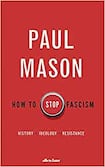
January 6th, 2021, will go down in history as a day of infamy. Although Trump supporters’ storming of the US Capitol doesn’t make its first appearance until a few dozen pages into How to Stop Fascism, author Paul Mason flags it as a “potentially historic turning point”. It is proof positive that leading liberal democracies are set for a fascist turn.
Correctly, Mason draws a sharp distinction between the populist far right and overt fascists. Trump is presented not as a fascist himself, but rather as an enabler, a “useful idiot”. Indeed, explicitly fascist parties are thin on the ground. Greece’s now-outlawed Golden Dawn is a notable exception, although fascist revivalism has been making its mark in both Italy and Spain of late.
For the former economics editor of Newsnight and Channel 4 news, this book marks a decidedly pessimistic and backward-looking turn. In his two most recent works – Post-capitalism: A Guide to Our Future (2015); and Clear Bright Future: A Radical Defense of the Human Being (2019) – Mason, in “techno-optimist” mode, hailed the coming obsolescence of the neoliberal economic model, seeing possibilities for new technologies to usher in an approximation of socialist utopia.
In How to Stop Fascism, the prevailing economic model is again at fault, just as interwar economic turmoil was instrumental in the rise of 20th century fascism in Italy and Germany. To explain why the far right in general, and fascism in particular, is resurgent, Mason points to “five kinds of trouble”: the neoliberal economic model never worked for ordinary people and has been dying a slow death since the global financial crisis; social media has changed how politics is conducted and democratised disinformation; people have lost trust in democracy; tackling climate change requires fundamental changes to how we live; and measures to suppress the Covid-19 pandemic have been a boon to conspiracy theorists and their far-right outriders. The cascading impact of these crises has, according to the author, created something of a perfect storm.
Added value
The book’s strengths, however, lie in the backward-looking elements encapsulated in its subtitle, covering respectively the history and ideology of fascism. The broad outlines of the rise of Hitler and Mussolini are well known to secondary school students of history but, while Mason covers this material well, there is real added value in his treatment of the ideas that motivated them, the social actors that facilitated them and the political actors who failed to stop them. As a counterpoint, he explains how unified political opposition, the Popular Front, and a zero-tolerance posture kept fascism at bay in pre-second World War France.
While allowing for cross-country differences, he breaks down what he calls the five propositions of 21st-century fascist “mythology”: immigration is increasing the share of the non-white population while abortion suppresses white birth rates, leading to a “great replacement”; liberal democracy is precipitating western decline, and must be replaced; woke culture, sometimes pejoratively labelled cultural Marxism, is destroying the West; spreading ideology and recruiting adherents, particularly via the internet, is the prime modus operandi; and a violent day of reckoning is in the offing. Indeed, Mason highlights throughout the glorification of violence, symbolic and otherwise, as central to the fascist creed.
Applying this taxonomy to Ireland in 2021, it is not difficult to find early warning signs on the far fringes of our politics. Social media-driven far-right populism has been on the rise, notably infiltrating and mobilising anti-vaccine and anti-immigration movements. Even QAnon has its Irish adherents. Although leading members of the Army Comrades Association may have flirted with fascism in the 1930s, Eoin O’Duffy becoming the first leader of Fine Gael before going on to fight for Franco, Ireland has fortunately never had an overtly fascist party, yet alone one counting on broad electoral support.
The resistance
Having drawn clear historical parallels with the rise of the far right in the 21st century, Mason proposes a political strategy of resistance, mirroring the above-mentioned Popular Front of interbellum France. Whereas at one point he assesses a “non-negligible risk of a fascist breakthrough”, however, much of the sometimes breathless concluding chapters suggests a clear and present danger. This distinction is non-trivial given the political strategy proposed. What is left unclear, however, is whether it is intended to “break glass in case of emergency” or, as seems to be implied, to be pursued immediately.
In practice, if it were even to be feasible, a Popular Front strategy would entail the effective suspension of normal political and policy debate, forging unity and consensus across the political spectrum from hard left to centre-right. In some ways, this harkens back to the post-war consensus – Butskellism, as it came to be known satirically in the UK. While acknowledging that ideological sacrifices would be required from all concerned, he is optimistic, for example, that such an anti-fascist bloc could coalesce around a Green New Deal, involving massive state investment to tackle climate change.
I am sceptical, fascist threat or not. Having left journalism to dedicate himself to political activism, it is perhaps unsurprising that Mason is prone to polemic. Even “as a writer working within the Marxist tradition”, to his credit, he doesn’t flinch from questioning rigid orthodoxies. This is particularly relevant given that orthodox Marxism not only failed to predict the rise of fascism, it did not even consider the theoretical possibility. Its “signal characteristic was its inability to grasp complexity”. Occasional fealty to the analysis of Leon Trotsky, and lionising of his Red Army, however, suggest that some orthodoxies die harder.
This is an erudite effort, of interest to anyone looking for a deep exploration of the origins of fascism or fearful that Trump, Bolsonaro or a resurgent far-right across Europe presage a return to humanity’s darkest hours. As ever, identifying the problem is easier than proposing the solution, and that is where this book falls down. We need to be alive to the far-right threat, but not become fixated on it to the exclusion of all else.











